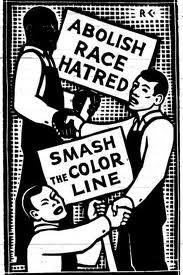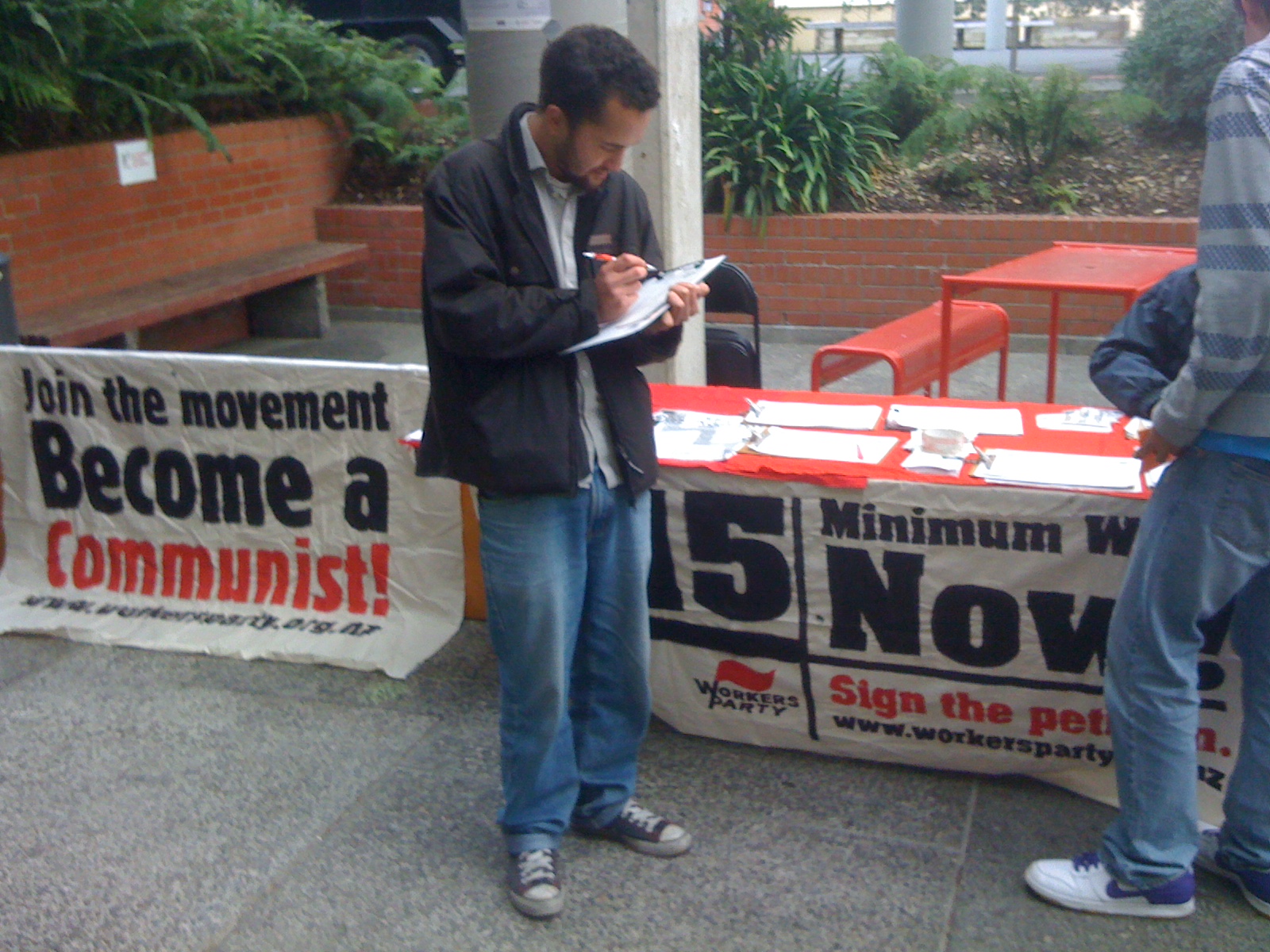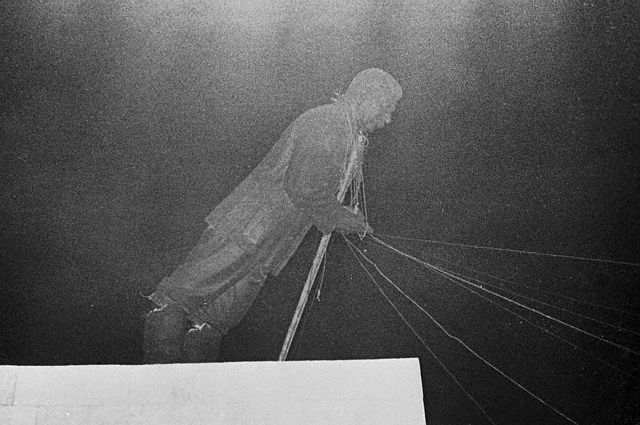Continuation of our discussion about communist organisation (On The Party Question and Demoralisation or Disorientation?)
Only he [sic] who can keep his heart strong and his will as sharp as a sword when the general disillusionment is at its worst can be regarded as a fighter for the working class or called a revolutionary.
Gramsci, Avanti, Piedmont edition, 24 September 1920
At the last Retreat, I raised the concept of the fighting (or “combat”) propaganda group as an appropriate model for the WP in current conditions. Whilst the idea seemed to meet with general approval, I haven’t had the chance to expand on it until now.
The WP now, and for the foreseeable future, needs to be a “fighting propaganda group”: an organisation whose chief concern is propaganda, but which conducts its propaganda while always immersing itself in and responding to the class struggle, and while always seizing every real opening for genuine agitation.
Plekhanov defined propaganda as conveying many ideas to a single person or to a few people, whereas agitation conveys only one or a few ideas to a whole mass of people. Since history is made by the mass, agitation is the aim of propaganda. Propaganda is directed towards the vanguard; agitation towards the masses.
Whilst the Bolsheviks remain our great inspiration as the leaders and organisers of the Russian Revolution, the experience of the US communist movement is also of great relevance to us. Rather than organising under conditions of Tsarist illegality with fledgling industrialisation, the US militants confronted bourgeois democracy with a massive proletariat. James P. Cannon wrote a great deal that is of value to the challenges of organising a fighting propaganda group. That is the starting point of this bulletin.
 Cannon’s Opposition
Cannon’s Opposition
Cannon describes how, as a delegate to the Sixth Congress of the Comintern in Moscow in 1928, he obtained a copy of Trotsky’s document “The Draft Programme of the Communist International: A Criticism of Fundamentals.” He and a fellow delegate, Maurice Spector from Canada, smuggled the document out to North America and began the struggle against Stalinism in the Communist movement there. Cannon had come to realise how “devotion to the Comintern, which had originally been one of the greatest merits of the pioneer communists, was being turned into a sickness which called for a radical cure.”
Cannon says there are two determinants of the fate of a young group: “The first is the adoption of a correct political programme. But that alone does not guarantee victory. The second is that the group decide correctly what shall be the nature of its activities, and what tasks it shall set itself, given the size and capacity of the group, the period of the development of the class struggle, the relation of forces in the political movement, and so on.”
Cannon conceived of a revolutionary group as representing “a dialectical unity of opposites. In one sense it is, in effect, the fusion of the rebel instincts of individuals with the intellectual recognition that their rebellion can be effective only when they are combined and united into a single striking force which only a disciplined organisation can supply.”
When the class struggle revived by the end of 1933, the nascent Trotskyist group adopted the slogan “Turn from a propaganda circle to mass work.” However, the decision “met determined resistance from comrades who had adapted themselves to isolation and grown comfortable in it.”
There were sharp disagreements within the Trotskyists over their fusion with the increasingly radical American Workers Party. The opposition insisted on the principle of the unconditional independence of the revolutionary party. Cannon’s reply was: “All that is correct… but there is just one screw loose in your argument. We are not yet a party. We are only a propaganda group. Our problem is to become a party. Our problem, as Trotsky pout it, is to get some flesh on our bones.”
Furthermore, Cannon argues, “The revolutionary labour movement doesn’t develop along a straight line or a smooth path. It grows through a continuous process of internal struggle. Both splits and unifications are methods of developing the revolutionary party. Each, under given circumstances can be either progressive or reactionary in its consequences.”
When joining the broader movement, Cannon said: “We enter the Socialist Party as we are, with our ideas.”
“Our first prescription for our people was: Penetrate the organisation, become integrated into the party, plunge into practical work and thus establish a certain moral authority with the rank and file of the party; establish friendly personal relations, especially with those elements of the party who are activists and therefore potentially of some use. Our plan was to let the political issues develop normally, as we were sure they would.”
Undoubtably the WP needs to restructure its organisation. However the task of reviewing our political lines is the prerequisite to this – “The organisational question is important, but the political line is decisive… Organisation questions are important only insofar as they serve a political line, a political aim.”
 The African American Question
The African American Question
“The early socialist movement, out of which the Communist Party was formed, never recognised any need for a special program on the Negro question. It was considered purely and simply as an economic problem, part of the struggle between the workers and the capitalists; nothing could be done about the special problems of discrimination and inequality this side of socialism.”
But following the October Revolution, the Comintern began to exert serious pressure on American socialists to “demand that they shake off their own unspoken prejudices, pay attention to the special problems and grievances of the American Negroes, go to work among them, and champion their cause in the white community.”
The Comintern also pushed for the slogan of “self-determination” in the thirties, although Cannon considered that the slogan “found little or no acceptance in the Negro community; after the collapse of the separatist movement led by Garvey, their trend was mainly toward integration, with equal rights. In practice the CP jumped over this contradiction. When the party adopted the slogan of ‘self-determination,’ it did not drop its aggressive agitation for Negro equality and Negro rights on every front.”
Whither the WP?
The history of US Trotskyism is rich in lessons for a small combat propaganda group such as the WP today. To take one stellar example, the leadership that the movement gave to the Minneapolis General Strike of 1934, remains an inspirational model for revolutionary socialists to this day. However there are also major differences in the situation in New Zealand today compared to Cannon’s “heroic” period: notably, vastly lower levels of class struggle, and the absence of a major Stalinist party. We should also bear in mind that Cannon’s group eventually degenerated into a sect that took on Stalinoid politics that it once struggled against so vehemently.
 Establishing the balance between propaganda and agitation is an on-going process, guided by the logic of the class struggle. The group must be flexible and responsive enough to engage with (and initiate) new struggles. Equally, it must continually assess the effectiveness of each intervention, drawing up a balance sheet to determine whether it merits the expenditure of our meagre resources. Our job is not to be “good citizens of the left”, people who religiously turn up to every demonstration and leftist meeting going. We select our activity on the basis of what is irreplaceable about the WP.
Establishing the balance between propaganda and agitation is an on-going process, guided by the logic of the class struggle. The group must be flexible and responsive enough to engage with (and initiate) new struggles. Equally, it must continually assess the effectiveness of each intervention, drawing up a balance sheet to determine whether it merits the expenditure of our meagre resources. Our job is not to be “good citizens of the left”, people who religiously turn up to every demonstration and leftist meeting going. We select our activity on the basis of what is irreplaceable about the WP.
A group like Redline, as a pure propaganda group is incapable of meaningful growth, because of their on-principle abstention from activism. (Although they have managed to act as a “sinkhole”, dragging one or two of our demoralised comrades down into passivity.) Even their ability to produce propaganda and analysis is limited by their disconnect from real struggles, which ensures they cannot do meaningful “reconnoissance” work in new formations such as Mana or the Occupy Movement.
Socialist Aotearoa, on the other hand, has a tendency to focus on agitation at the expense of propaganda, meaning that it lurches from one frenetic activity to the next, without assimilating the lessons in a coherent and continually developing world view to guide future struggles; they fail to function as the “memory of the class.” Nevertheless, the potential in the coming period for joint work with the likes of SA is far greater than it is with Redline.
On specific political questions, in previous IDBs I’ve argued that we should pay greater attention to the questions of Māori oppression and Stalinism.
A common left criticism of the Israeli “tent city” protest movement was that it was very vocal about the level of rents for apartments and the price of cottage cheese, but very quiet about the oppression of the Palestinians. However, the WP has until recently been muted in its criticism of the special oppression experienced by Māori in Aotearoa. We are currently in the process of rectifying this major failing.
 Stalinism is largely a historical question, but it casts a long dark shadow over the Socialist outlook in the 21st Century. Even if the bureaucratic states have not endured, the modes of thinking that they gave rise to are still with us. In 2012 we must begin the discussion on Stalinism in earnest. We also need to address why it is that comrades have not been forthcoming with substantial written replies to the IDBs tabled so far.
Stalinism is largely a historical question, but it casts a long dark shadow over the Socialist outlook in the 21st Century. Even if the bureaucratic states have not endured, the modes of thinking that they gave rise to are still with us. In 2012 we must begin the discussion on Stalinism in earnest. We also need to address why it is that comrades have not been forthcoming with substantial written replies to the IDBs tabled so far.
The motto that Cannon used to quote was: “do what is necessary, not what is possible.” Retooling the WP as a fighting propaganda group for New Zealand conditions is the task we must set ourselves.
Mike Kay
01 January 2012
Sources
Cannon, J.P. (1972) The History of American Trotskyism Pathfinder
Cannon, J.P. (1962) The First Ten Years of American Communism Pathfinder
